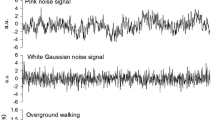Abstract
This paper solves the phase trajectory approximation problem. Quasiperiodic time series form its trajectory in high dimensional space. The trajectory is represented in the spherical coordinate system. To approximate the trajectory the authors use a directional regression technique. It finds space of minimal dimension with the phase trajectory has no self-intersections. Its self-intersections defined within the standard deviation of the reconstructed trajectory. The experiment was conducted on two data sets: data of electricity consumption during the year and sensor data of the accelerometer while walking and running.




Similar content being viewed by others
REFERENCES
M. Zhang and A. A. Sawchuk, ‘‘USC-HAD: A daily activity dataset for ubiquitous activity recognition using wearable sensors,’’ in Proc. 2012 ACM Int. Conf. on Ubiquitous Computing (UbiComp’12), Pittsburgh, PA, September 5–8, 2012, Workshop on Situation, Activity and Goal Awareness (Assoc. Comput. Mach., New York, 2012), pp. 1036–1043.
Energy Consumption Data. https://sourceforge.net/p/mvr/code/HEAD/tree/data/ EnergyConsumption.xls.
N. Golyandina and D. Stepanov, ‘‘SSA-based approaches to analysis and forecast of multidimensional time series,’’ in Proc. 5th St. Petersburg Workshop on Simulation, June 26 – July 2, 2005 (St. Petersburg State University, St. Petersburg, 2005), pp. 293–298.
N. Golyandina, V. Nekrutkin, and A. A. Zhigljavsky, Analysis of Time Series Structure: SSA and Related Techniques (Chapman and Hall/CRC, Boca Raton, 2001).
N. Golyandina and A. Zhigljavsky, Singular Spectrum Analysis for Time Series (Springer, Berlin, Heidelberg, 2013).
G. Sugihara, R. May, Hao Ye, H. Chih-hao, E. Deyle, M. Fogarty, and S. Munch, ‘‘Detecting causality in complex ecosystems,’’ Science 338, 1227079 (2012).
G. Sugihara and R. May, ‘‘Nonlinear forecasting as a way of distinguishing chaos from measurement error in time series,’’ Nature 344 (6268), 734–741 (1990).
K. R. Usmanova and V. V. Strijov, ‘‘Models of detection of relationship between time series in forecasting problems,’’ Sist. Sredstva Inf. 29 (2), 12–30 (2019).
A. M. Katrutsa and V. V. Strijov, ‘‘Stress test procedure for feature selection algorithms,’’ Chemom. Intell. Lab. Syst. 142, 172–183 (2015).
J. Li, K. Cheng, S. Wang, F. Morstatter, R. P. Trevino, J. Tang, and H. Liu, ‘‘Feature selection: A data perspective,’’ ACM Comput. Surv. 50 (6), Article 94 (2017).
B. Li and S. Wang, ‘‘On directional regression for dimension reduction,’’ J. Am. Stat. Assoc. 102 (479), 997–1008 (2007).
B. Li, H. Zha, and F. Chiaromonte, ‘‘Contour regression: A general approach to dimension reduction,’’ Ann. Stat. 33 (4), 1580–1616 (2005).
Z. Yu, Y. Dong, and M. Huang, ‘‘General directional regression,’’ J. Multivar. Anal. 124, 94–104 (2014).
M. Hušková, Z. Prášková, and J. Steinebach, ‘‘On the detection of changes in autoregressive time series I. Asymptotics,’’ J. Stat. Plann. Inference 137 (4), 1243–1259 (2007).
B. Chen and Y. Hong, ‘‘Testing for smooth structural changes in time series models via nonparametric regression,’’ Econometrica 80 (3), 1157–1183 (2012).
Code for Constructing Trajectory Expected Value. https://github.com/Intelligent-Systems-Phystech/ SphericalRegression/tree/master/code/approx_trajectory_with_mean.ipynb.
Code for Applying Directional Regression. https://github.com/Intelligent-Systems-Phystech/ SphericalRegression/tree/master/code/apply_dr.ipynb.
Funding
This paper contains results of the project Mathematical methods of intelligent big data analysis, which is carried out within the framework of the Program ‘‘Center of Big Data Storage and Analysis’’ of the National Technology Initiative Competence Center. It is supported by the Ministry of Science and Higher Education of the Russian Federation according to the agreement between the M.V. Lomonosov Moscow State University and the Foundation of project support of the National Technology Initiative from 11.12.2018, No 13/1251/2018. This research was supported by RFBR (projects 19-07-01155, 19-07-00885).
Author information
Authors and Affiliations
Corresponding authors
Additional information
Translated by E. Oborin
About this article
Cite this article
Usmanova, K.R., Zhuravlev, Y.I., Rudakov, K.V. et al. Approximation of Quasiperiodic Signal Phase Trajectory Using Directional Regression. MoscowUniv.Comput.Math.Cybern. 44, 196–202 (2020). https://doi.org/10.3103/S0278641920040068
Received:
Revised:
Accepted:
Published:
Issue Date:
DOI: https://doi.org/10.3103/S0278641920040068




